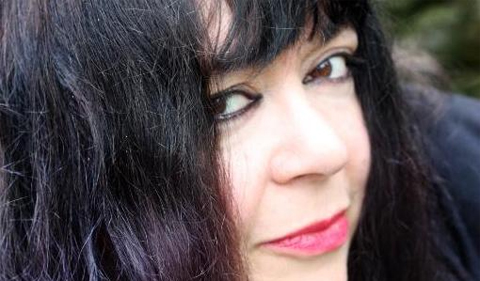
Diane Seuss
The Ohio University Creative Writing Program hosts Visiting Poet Diane Seuss, for a reading on Thursday, Dec. 7, at 7:30 p.m., in Walter Hall Rotunda.
By Abby Mohler, intern for the Office of Special Programs
The poet Diane Seuss writes imaginatively, lyrically, and lushly about the transition from girlhood and womanhood in her most recent collection, the 2015 Pulitzer Prize Finalist Four-Legged Girl. The speaker divides her journey into five different sections: “blossomhouse,” “blowtorch the hinges,” “lush,” “free beer,” and “a period’s period.” Throughout these sections, the speaker recalls her ever-shifting relationship with desire as she moves through different incarnations of herself. In the final section, “a period’s period,” Seuss writes, “Feasting on the younger versions of ourselves, / that’s what we do”—and the reader is fortunate to share in the feast. In this book and in much of her work, Seuss creates a deliciously complex character as she dissects and examines desire. Through this recollection of desire, she examines the nature of memory and nostalgia as well.
In Four-Legged Girl, the speaker’s episodes draw from Seuss’s real-life experiences, specifically the period when she lived in New York City as a twenty-something. She recounts brushing up against the likes of William Burroughs, Andy Warhol, and Jackie Curtis. A newcomer from a tiny Midwestern town, Seuss’ speaker observes the scene from the margins. She explains in an interview with Kaveh Akbar for Divedapper, “I . . . related to New York as a hick, that is, with a high attention to small details and an intense identification with my location.” The luxuriant landscape that she both reports and creates for the reader often shifts from the concrete to the surreal. In an interview with Matthew Thorburn for Ploughshares, Seuss describes the speaker of Four-Legged Girl “as a kind of picaresque character—mugging, mocking, relishing the subjective, and spraying the landscape, whether urban or rural, with her unreliable too-muchness.” The speaker’s landscape of “too-muchness” is littered with ghosts, junkies, sex, death, and a careful rejection of romanticization of the past.
In one scene from the long poem “I can’t listen to music, especially ‘Lush Life,’” the speaker finds herself seduced by a memory, one where “I lie on my back in the Retiro, braless, wearing a white / lace blouse.” Seuss describes the art which this remembered woman has made of herself, overlaid with the art which the poet makes of memory. This type of art, Seuss, implies, is dangerous:
I’ve cut my own hair and it’s short as a nun’s.
I’m playing dead, like Lorca did at parties. Hit me
over the head with his sugary femur.
Nostalgia is depression. Who said that?
Throughout the collection, Seuss’s playful language blurs the dividing lines between the allure of love and the allure of grieving for those she has lost, even as she reminds herself and the reader not to confuse the two. This is a collection of vibrant imagery, powerful yet precisely rendered emotion, and painful portraits of those who “claw [their] way to the bottom / [and] transcend downward.”
Seuss has published her work widely, including in Poetry Magazine, Brevity, and Best American Poetry 2014. She has also written two other collections of poetry, It Blows You Hollow (1998) and Wolf Lake, White Gown Blown Open (2010), which won the Juniper Prize for Poetry. Her forthcoming collection, entitled Still Life with Two Dead Peacocks and a Girl, will be published by Graywolf Press in 2018.
In her interview with Thorburn, Seuss called writing this forthcoming book “the most glorious writing experience of my life.” As Four-Legged Girl so completely captivated me with its continual unexpectedness, breathtaking portrayals of lust and loss, and gorgeously nuanced exploration of memory, I look forward to devouring Still Life as greedily as I did Four-Legged Girl.



















Comments